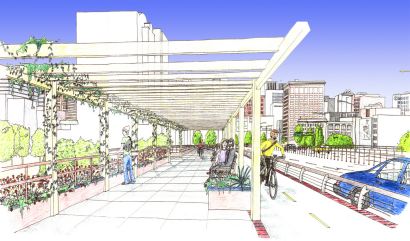
(Concept drawing by Phil Goff)
This first-person retrospective of the evolution of bikeway improvements on the Morrison Bridge is written by Phil Goff. Goff now lives in Arlington, Mass and is the manager of Alta Planning + Design’s Boston Field Office. He lived in Portland from 1996 to 2004, where he was an active BTA volunteer and a seven-year member of the City of Portland Bicycle Advisory Committee.
Sometime in the coming weeks, construction work on the Morrison Bridge will end and for the first time in history people on bikes will be able to safely cross the bridge.
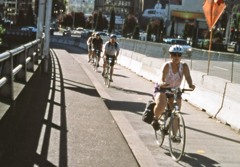
(Photo: Phil Goff)
Current construction has lasted for about a year — but the struggle to redevelop the bridge as a multi-modal facility began twelve years ago and represents yet another triumph of bike advocacy in Portland.
In 1997, Multnomah County closed the Hawthorne Bridge for a two-year rehabilitation project, which included widening its narrow sidewalks to their current width: 10 feet on each side.
To accommodate the 3000 cyclists wishing to access downtown each day during construction, the County provided a temporary facility on the Morrison Bridge. A ten-foot wide, two-way sidepath on the south side of the bridge was separated from traffic by Jersey barriers.
“My plan called for the elimination of an east-bound car travel lane and the expansion of the five-foot wide south sidewalk into a 25 foot wide esplanade.”
The temporary path worked so well that many thought it should be made permanent. In the spring of 1998, I began a postcard campaign to convince Multnomah County to do just that.
I handed out a thousand postcards to cyclists as they came over the bridge into downtown. Within weeks, nearly five hundred were signed and mailed in. While this got the County’s attention, it did not take long for bridge engineers to determine that the facility was planned for a short life span and was not the appropriate design for the long term.
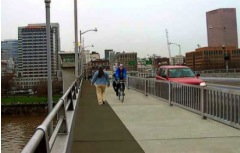
improvements.
(Multnomah County, 2004)
The County did, however, agree to submit a $1.5 million Transportation Improvement Project (TIP) request to Metro to fund the design and construction of a permanent facility. While this was a victory of sorts, I soon found out that the bi-annual TIP process was extremely competitive with only one out of three project requests granted the Federal transportation funds.
For the Morrison Bridge rehab project to stand out, a future vision was needed to catch the eyes of the decision makers and to galvanize the advocacy community. Soon after finishing my graduate degree in architecture, I developed a design for the Morrison Bridge and used the drawings as lobbying tools to build support at all levels of government.
Rather than a facility designed for transportation purposes only—like all of Portland’s other bridges—I envisioned a grand public space on top of the river. A multi-modal greenway esplanade across the Morrison Bridge would connect Waterfront Park with the Eastbank Esplanade which was then under construction.
“But despite the project’s visibility and high ranking by Metro staff 11th hour political maneuvering removed the full construction funding request in order to provide additional money for road and transit projects.”
To achieve this, my plan called for the elimination of an east-bound car travel lane and the expansion of the five-foot wide south sidewalk into a 25 foot wide esplanade. The wide space would be divided into a two-way bike path next to a 15 foot wide strolling space, lined with a continuous planter, intermittent benches and pedestrian-scale lighting.
As a lobbying tool, the “Greenway Esplanade” concept and drawings (see above) helped convince many of the key regional decision makers to support the $1.5 million funding request.
But despite the project’s visibility (The Oregonian published the drawings on two separate occasions) and high ranking by Metro staff (based on project evaluation criteria), 11th hour political maneuvering removed the full construction funding request in order to provide additional money for road and transit projects.
With help from PDOT Commissioner Charlie Hales and Metro Councilor David Bragdon, $200,000 was ultimately granted to the County to complete the project’s first steps: the design and engineering work. In 2001, during the next funding cycle, the process began again. I printed and handed out another thousand postcards, this time addressing them to Rod Monroe, Chair of the Metro Council.
Activists from the Bicycle Transportation Alliance, Coalition for a Livable Future, Willamette Pedestrian Coalition and others came to this round of hearings in greater numbers to support a slate of bicycle and pedestrian projects including this one and, also successfully, the three new bridges along the Springwater Trail.
The additional two years of effort paid off — the Morrison Bridge project was granted the full $1.5 million request.
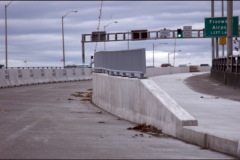
on the south side of the bridge.
(Photo © Adams Carroll)
In 2003, the design and engineering work began. The County appointed me to the Project Advisory Committee and I fought hard to maintain my vision for a grand public space over the river. This was not to be as City and County engineers determined that it was not feasible to remove an east-bound lane of car traffic.
Maintaining the six car travel lanes on the bridge provided only an additional ten feet of space to play with, and the consensus of the committee and the public was to shift this extra width to the south sidewalk. The relatively low budget and the resulting fifteen-foot multi-use path could not accommodate the landscape improvements and park benches that I had envisioned years earlier.
The “new” Morrison Bridge that you will soon be walking and cycling over is the result of that process. It could hardly be considered a greenway or an esplanade, but it will provide a great multi-modal transportation facility and take some pressure off of the Hawthorne Bridge’s congested sidewalks.
Eventually, the Morrison Bridge bikeway will become just as busy as Hawthorne’s. At that point, someone will need to lead the fight for a new and bold way to serve the ever-increasing number of people crossing the Willamette River on foot or by bike.
[Publisher’s note: Multnomah County says completion of the Morrison Bridge project has been delayed until late January. We’ll update you as soon as we have more details. Browse our previous coverage of this project here.]



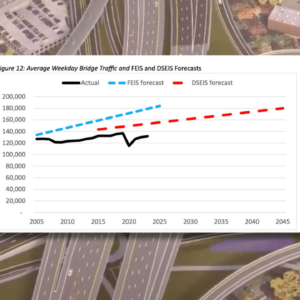
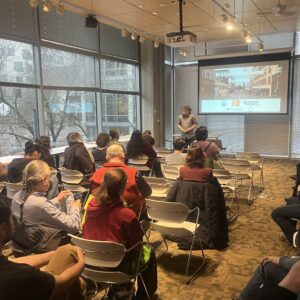
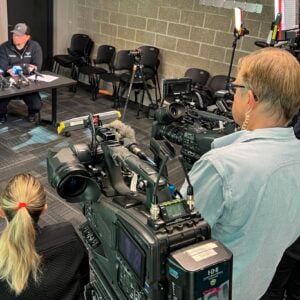
Thanks for reading.
BikePortland has served this community with independent community journalism since 2005. We rely on subscriptions from readers like you to survive. Your financial support is vital in keeping this valuable resource alive and well.
Please subscribe today to strengthen and expand our work.
“… for the first time in history people on bikes will be able to safely cross the bridge.” ?!? Come on.
an extremely informative piece. and many thanks to phil goff for all your hard work.
Guilty as charged with hyperbole. Dan is right, I certainly rode over the bridge dozens of times and did so safely. I can’t say it was a very comfortable experience however, especially if there was someone walking on the narrow sidewalk.
For those who were not in Portland at that time, Phil’s tireless work on this issue (as well as the work of others) has helped to connect this bridge. Every time we ride over it, we owe Phil a serious debt!
Thanks Phil for this helpful background and for all your activism.
Thanks again for the article Phil. On a related note, do folks think it would be worthwhile to ask Multnomah County to place a plaque on the bridge giving some historical context and expressing gratitude for the activists who worked on this project?
Phil, thanks for your work and for the results–no more “dry days only” for riding the Morrison!
Phil’s missing a few details, such as:
1. there was already a county study recommending the installation of bike facilities on the Morrison Bridge at the time of the Hawthorne Bridge closure/detour in 1997.
2. the county only provided the temporary detour on the Morrison Bridge in 1997 after significant pressure from cyclists was brought to bear on the city and the county; the county had initially proposed that cyclists detour from the Hawthorne Bridge all the way to the Burnside Bridge; also, what is now the Eastside Esplanade didn’t exist at the time and the city had to pave sections of unpaved path by the fireboat station to make the temporary Morrison Bridge Path accessible from the Hawthorne viaduct.
There’s nothing like being informed by the back story. Thanks!
Looking forward to the update – this is the second time the project has been delayed – the original projected completion date was October. I’m very eager to learn why the contractor has been unable to complete the project on time – I’d also like to know if the county will be compensated for that. If this were a roadway project rather than a side path, there would be a public outcry, even though there are parallel routes on the other bridges.
And as a side note, are there any signs on either end of the project listing the projected completion date and a phone number for updates? If not, why not?
Elly Blue’s photostream on Flickr has an easier photo to view of the bridge under construction:
http://www.flickr.com/photos/ellyblue/3909259756/
I wonder, if the 90 foot wide bridge could support a sub-story esplanade, so that the Portland-Goff esplanade, a kind of High Line for Portland, could be realized? With increased usage, in time the first design esplanade overspill of foot traffic would have conflicted with fast-moving cyclists, no? Fill in those spaces underneath with a walkway?
Wikipedia is saying that the steel structure underneath is due to be updated? Of course, it all has to swing upon from time to time. Wikipedia also says it’s the largest mechanical device in Oregon. Sorry, Phil, your couch-pedicab doesn’t win.
-nycpedicab
a big tip o’ the helmet, Phil — the timing of this project coming on line couldn’t be better. When your efforts began 13 years ago, it would have been hard to foresee that one of the biggest benefits of this project would be to help relieve the bike/ped congestion on the (new wide-sidewalked) Hawthorne Bridge.
Impressively prescient!
Can your cartoonist do a drawing of Dan riding on the Morrison?
It would be nice to see comparison photos of bike ways on bridges, even if they are just a lined path.
It takes many good people and many long years to bring a project to completion.
The context for this new facility is priceless, thank you Phil.
I think the perspective is interesting. The new improvements are certainly a win, but by no means are we innovating here. We failed to see the bridge as the public space asset that it is, but rather see it only as a way to get people from A to B.
The concept drawing is stunning. It seems as though we should continue to push for the widening of space for active road users, on all our bridges. If we’re going to walk the walk, we shouldn’t be afraid to take a travel lane on a 6 lane bridge.
BURR is right. Multnomah County’s 1993 study recommended a bike path on the Morrison Bridge (and many of the other bike improvements built since that time on the other bridges).
But can’t wait to ride the path!
Now if only we could get those “No Bike” signs taken down from the approaches and give cyclists real choice in crossing the bridge. I feel that many cyclists, myself included, would prefer to take the lane and avoid any incidents with pedestrians.
Taking down the “no bike” signs will be insufficient, once a “bike path” is built. ORS 814.420 makes the path mandatory.
I rode over the new path on Christmas Day, there’s a few missing pieces, but it’s totally doable.
Thanks so much, Phil and others, for making this happen!
Keep up the good work, Portlanders — hold city council’s feet to the fire and tell them you want lots more bike infrastructure in the pipeline so when this year’s improvements fill up in a couple years, there’s lots more coming online!
Ted Buehler
Ted (#19) – And the county and state’s feet. The Willamette bridges do not belong to the city – Ross Island, Freemont and Marquam bridges are owned by ODOT; Sellwood, Hawthorne, Morrison, Burnside and Broadway are owned by the county. Steel is owned by the Union Pacific Railroad, good luck there.
You rock Phil! Thanks for all your hard work on this and your continue monitoring from afar.
Can’t wait to try out the new path!
Any update on this Jonathan or Elly?